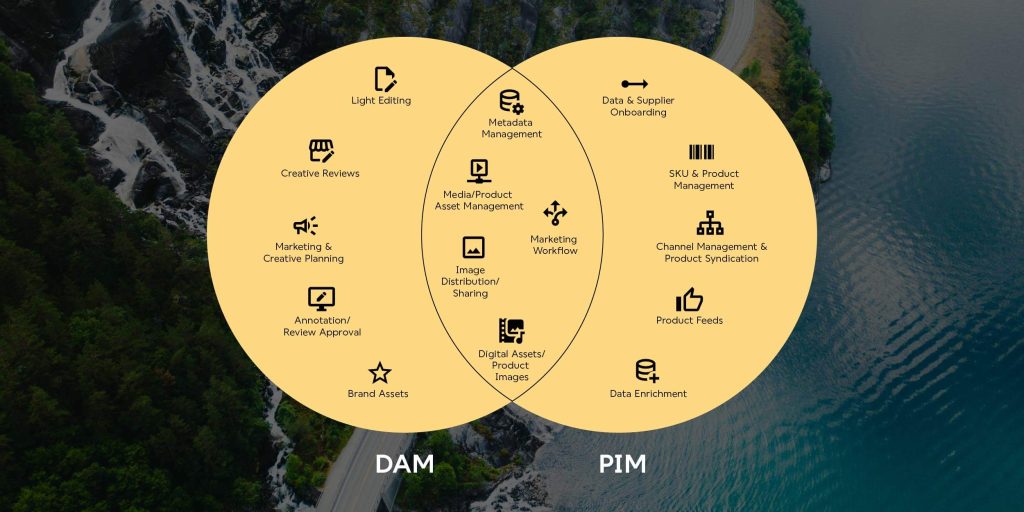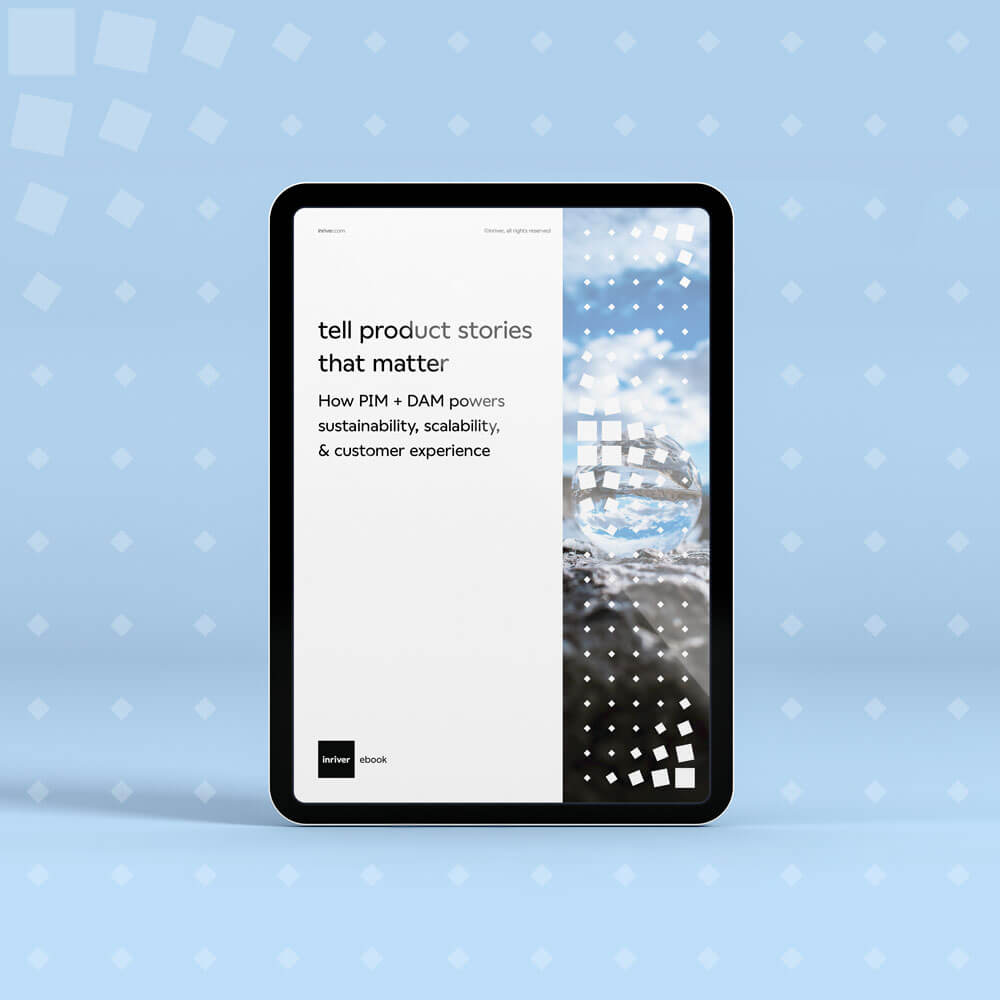DAM vs PIM: How to create memorable product stories
January 20, 2023Part 3: Want to enrich your product stories at every touchpoint? Find out which solution is right for your digital assets.
Who doesn’t like exploring amazing new places and capturing the magic on camera? When you’re on a trip, snapping thousands of photos along the way enhances the experience and captures the memories. If you’re an amateur photographer, you may not know what to pack for your trip. You have a trusted camera, but could trying a different lens make your travel photos even better?
Liken this to your product journey. You aim to create digital assets that stand out from the crowd and make your product stories visually appealing and compelling. In today’s vast consumer environment, enterprises have a massive library of digital assets. From logos to training videos to product photos, ensuring the quality and accuracy of these assets is essential. If you’re building your product journey, what’s the best solution to maximize the value of your assets across all your channels and power the entire journey?
> You need more than one lens to streamline your digital data
> DAM or PIM?
> PIM and DAM integration
> DAM or PIM: which solution is right for me?
You need more than one lens to streamline your digital data
Creating a successful omnichannel roadmap for your product means looking through a data-centric lens at all your product information. This includes your digital assets, from product images and videos to brand logos and social media assets. To meet various demands on your product assets, you’ll need to secure a single source of truth for all these assets.
But which digital assets are we talking about here? And what lens do you need?
Firstly, there are organization-wide digital media assets. This includes internal assets like training videos, as well as external-facing assets such as logos and promotional materials that help protect and standardize your brand identity. This lens is your brand view.
Secondly, there are all the digital assets related to your product. This includes all images, diagrams, videos, and more, that will be distributed to sales channels. It also includes all documentation that supports the go-to-market process, such as sustainability specifications. This lens is your product view.
Both lenses are business-critical and require the right software for the task. But if you’re searching for solutions, you’ll typically come across two software options that meet these needs:
- Digital Asset Management (DAM)
- Product Information Management (PIM)
Which one is right for you?
DAM or PIM?
If you’re trying to work out which of these solutions best meets your needs, first understand your options:
What is DAM?
Digital Asset Management (DAM) lets you store, organize, manage, and share all your organization-wide digital assets in a centralized hub. This includes:
- logos
- videos
- metadata
- layouts
- promotional materials
Employees and other stakeholders have controlled access to find and use your digital assets quickly, easily, and securely. This includes writers, designers, and marketers in charge of your brand communication, new employees watching product videos, or even your compliance team who need to monitor various legalities for the wider organization.
Benefits of DAM
Employees and other stakeholders have controlled access to find and use your digital assets quickly, easily, and securely. This includes writers, designers, and marketers in charge of your brand communication, new employees watching product videos, or even your compliance team who need to monitor various legalities for the wider organization.
What is PIM?
Product Information Management (PIM), on the other hand, focuses on comprehensive product data management, from descriptions and specifications to pricing and marketing material. PIM is a marketing and merchandising tool that lets you store, manage, and distribute accurate product information to sales channels. The data contained within a PIM solution is used to meet external demands for product-related information, including:
- Sales
- Marketing
- After-sales
For a deeper dive into PIM, read how the inriver solution powers the full product journey.
What are the main differences between DAM and PIM?
To understand PIM and DAM software, it’s important to know the similarities and differences between these two software solutions.

For starters, both solutions provide storage and management of digital assets. They also both improve efficiency and enhance the customer journey by ensuring accurate, up-to-date digital assets for a consistent brand and customer experience. Finally, both solutions also save you time and money by speeding up time-to-market and automating the distribution of digital and product assets. However, there are also key differences between the two solutions.
A DAM system is an enterprise-wide application that stores and manages all digital assets and files (both structured and unstructured) for the entire organization. Permission management is another crucial feature, ensuring that only authorized personnel can access and modify product-related information. Catering to both internal and external audiences, DAM systems extract more value from your assets by ensuring they can be easily retrieved and standardized across your organization.
A PIM system is a business-led initiative that focuses on merchandizing the product. It stores, manages, and distributes only those assets related to the product and product cycle to support marketing, sales, and after-sales processes. PIM systems extract more value from your assets by ensuring they can meet the dynamic needs of your business operations through the effective promotion of products. This can add significant value if you have a large variety of SKUs and/or sales channels.
Still not sure which solution is right for you? Let’s see if they can work together.
PIM and DAM integration
You may already have one of these solutions in your tech stack, or your business needs may not be met by just one alone. In this case, you’ll probably want to know if integrating DAM and PIM platforms is possible.
Many large enterprises integrate both DAM and PIM to get the best of both worlds and extract the most value from their digital assets. Integrating the two solutions drives internal best practices to ensure there is a single source of truth for all assets across all processes and sales channels.
Integrating DAM and PIM can also translate into real implications for your revenue and ROI, through a faster time-to-market, improved internal efficiency, and external consistency. To build a personalized and contextual path to purchase, both product content and digital assets need to be searchable, accurate, enriched, and ready to publish. This ensures personalized engagement for the buyer, improved CX, and, ultimately, revenue growth. Learn more about the potential ROI of PIM to further inform your approach.
For more information on integrating the two solutions, read our guide to PIM + DAM.
DAM or PIM: which solution is right for me?
Both DAM and PIM are simple, scalable solutions that are easy to integrate within virtually any business ecosystem. But which is right for your ecosystem? And which lens do you need for your product journey?

Firstly, you need to consider your use cases. Are you looking for an organization-wide repository for all your digital assets, from personnel headshots to SKU-level images? Or are you in need of something that will optimize your product-related assets to streamline your go-to-market strategy?
If you’re looking for a business-led software solution that helps you maximize profitability out of your digital assets at every touchpoint, then PIM is your answer. PIM’s capacity to provide a single source of product truth can meet your internal and external demands for optimized, accurate, and relevant product assets while eliminating those manual errors and delays that can quickly derail your omnichannel strategy.
PIM architecture software is also configurable. It grows with your needs and demands, meaning it can act as a jumping-off point for your entire digital transformation. For example, starting with a PIM can help you meet your asset needs while taking advantage of the many connectors available for PIM, such as print tools. Later in your digital transformation journey, you may then decide to integrate further asset-related solutions, such as DAM, to meet your needs.
want to see the inriver PIM in action?
Schedule a personalized, guided demo with an inriver expert today to see how the inriver PIM can get more value from your product information.
you may also like…
frequently asked questions
is CMS a PIM or DAM?
A Content Management System (CMS) is neither a PIM nor a DAM, but it can work in conjunction with both. Understanding the role of PIM vs CMS is crucial: A CMS primarily focuses on creating, managing, and publishing digital content for websites and other digital platforms. While a CMS manages web content, a PIM manages product information, and a DAM manages digital assets. Integrating these systems can create a comprehensive digital ecosystem, where the CMS pulls product data from the PIM and digital assets from the DAM to provide a cohesive online experience.
can a DAM system handle product information like a PIM?
While a DAM system excels at managing and organizing digital assets such as images, videos, and promotional materials, it is not designed to handle the comprehensive product data management that a PIM system provides. A PIM system manages detailed product information, including descriptions, specifications, pricing, and marketing materials, ensuring that this data is accurate and consistent across all sales channels. Integrating DAM and PIM systems is often the best approach for complete product information management.
how does integrating PIM and DAM systems enhance the customer experience?
Integrating PIM and DAM systems enhances the customer experience by ensuring that all product-related information and digital assets are accurate, up-to-date, and easily accessible across all touchpoints. This integration allows businesses to provide a seamless and consistent brand experience, from product discovery to purchase. It ensures that customers receive rich, contextual content that is personalized to their needs, leading to improved engagement, satisfaction, and ultimately, higher conversion rates.
author
Tomas Bylander
Director of Software Development
As the Director of Product Development, Tomas leads a team of developers, testers, SRE and security engineers. Through their passion for software development and PIM, they solve customers' problems through solutioning and implementation. Tomas has 15 years of experience from software development in various industries and continues to grow in the role while creating the next generation of inriver PIM.
Read more
